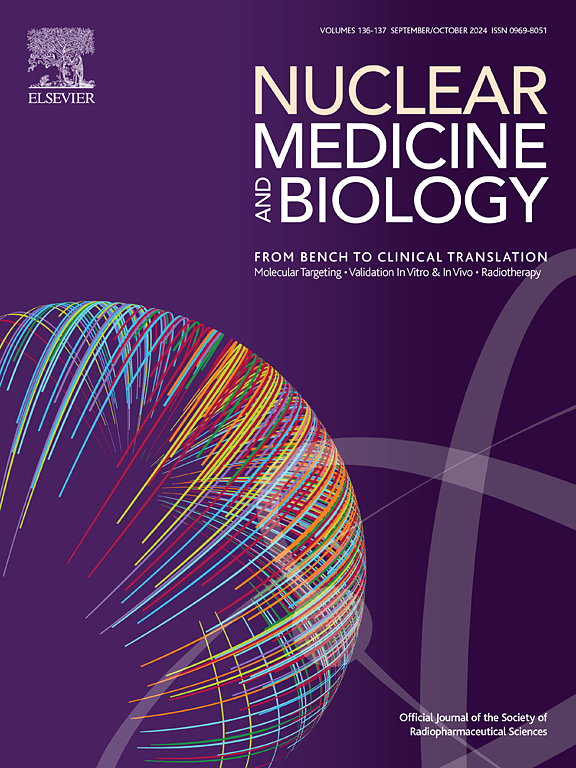Optimization and scale-up of [68Ga]Ga-FAPI-46 production on a Modular-Lab PharmTracer platform for clinical application
IF 3.6
4区 医学
Q1 RADIOLOGY, NUCLEAR MEDICINE & MEDICAL IMAGING
引用次数: 0
Abstract
Background
Due to the increasing application of the fibroblast activation protein (FAP) targeting radiotracer [68Ga]Ga-FAPI-46 in cancer diagnostics by PET/CT, there is a need for a convenient way for routine production of high activities of this tracer. The aim of the current work is the optimization and scale-up of an automated method for [68Ga]Ga-FAPI-46 production on a PharmTracer module using two GalliaPharm generators.
Results
Several labeling conditions were evaluated and the best results were obtained with 40 μg of precursor, 3 mg ascorbic acid as anti-radiolysis agent, 0.4 M sodium acetate buffer pH 4.5 and 15 min heating at 95 °C. Furthermore, Vitamin C was added to the final formulation as stabilizer to ensure product quality in a time frame of 3 h after the end of synthesis. The evaluation of 43 routine syntheses of [68Ga]Ga-FAPI-46 resulted in a decay-corrected yield of 91.1 ± 3.4 % and radiochemical purity of 99.8 ± 0.3 % as determined by radio-HPLC. All the quality control parameters were in accordance with specifications.
Conclusions
In conclusion, we developed an efficient and robust method able to provide multiple doses of [68Ga]Ga-FAPI-46, enabling a better response to the clinical need for this radiopharmaceutical.

模块化实验室PharmTracer平台上[68Ga]Ga-FAPI-46临床应用的优化和规模化生产
随着成纤维细胞激活蛋白(FAP)靶向放射性示踪剂[68Ga]Ga-FAPI-46在PET/CT癌症诊断中的应用越来越多,需要一种方便的方法来常规生产这种高活性的示踪剂。当前工作的目的是使用两个GalliaPharm发生器在PharmTracer模块上优化和扩大[68Ga]Ga-FAPI-46生产的自动化方法。结果采用前体40 μg、抗坏血酸3 mg作为抗辐射剂、醋酸钠0.4 M pH 4.5缓冲液、95℃加热15 min的标记条件获得最佳标记效果。在最终配方中加入维生素C作为稳定剂,在合成结束后3 h内保证产品质量。43种常规合成[68Ga]Ga-FAPI-46的评价结果表明,经衰变校正的收率为91.1±3.4%,放射化学纯度为99.8±0.3%。所有质量控制参数均符合规范要求。结论建立了一种高效、可靠的方法,能够提供多剂量的[68Ga]Ga-FAPI-46,能够更好地满足临床对该放射性药物的需求。
本文章由计算机程序翻译,如有差异,请以英文原文为准。
求助全文
约1分钟内获得全文
求助全文
来源期刊

Nuclear medicine and biology
医学-核医学
CiteScore
6.00
自引率
9.70%
发文量
479
审稿时长
51 days
期刊介绍:
Nuclear Medicine and Biology publishes original research addressing all aspects of radiopharmaceutical science: synthesis, in vitro and ex vivo studies, in vivo biodistribution by dissection or imaging, radiopharmacology, radiopharmacy, and translational clinical studies of new targeted radiotracers. The importance of the target to an unmet clinical need should be the first consideration. If the synthesis of a new radiopharmaceutical is submitted without in vitro or in vivo data, then the uniqueness of the chemistry must be emphasized.
These multidisciplinary studies should validate the mechanism of localization whether the probe is based on binding to a receptor, enzyme, tumor antigen, or another well-defined target. The studies should be aimed at evaluating how the chemical and radiopharmaceutical properties affect pharmacokinetics, pharmacodynamics, or therapeutic efficacy. Ideally, the study would address the sensitivity of the probe to changes in disease or treatment, although studies validating mechanism alone are acceptable. Radiopharmacy practice, addressing the issues of preparation, automation, quality control, dispensing, and regulations applicable to qualification and administration of radiopharmaceuticals to humans, is an important aspect of the developmental process, but only if the study has a significant impact on the field.
Contributions on the subject of therapeutic radiopharmaceuticals also are appropriate provided that the specificity of labeled compound localization and therapeutic effect have been addressed.
 求助内容:
求助内容: 应助结果提醒方式:
应助结果提醒方式:


